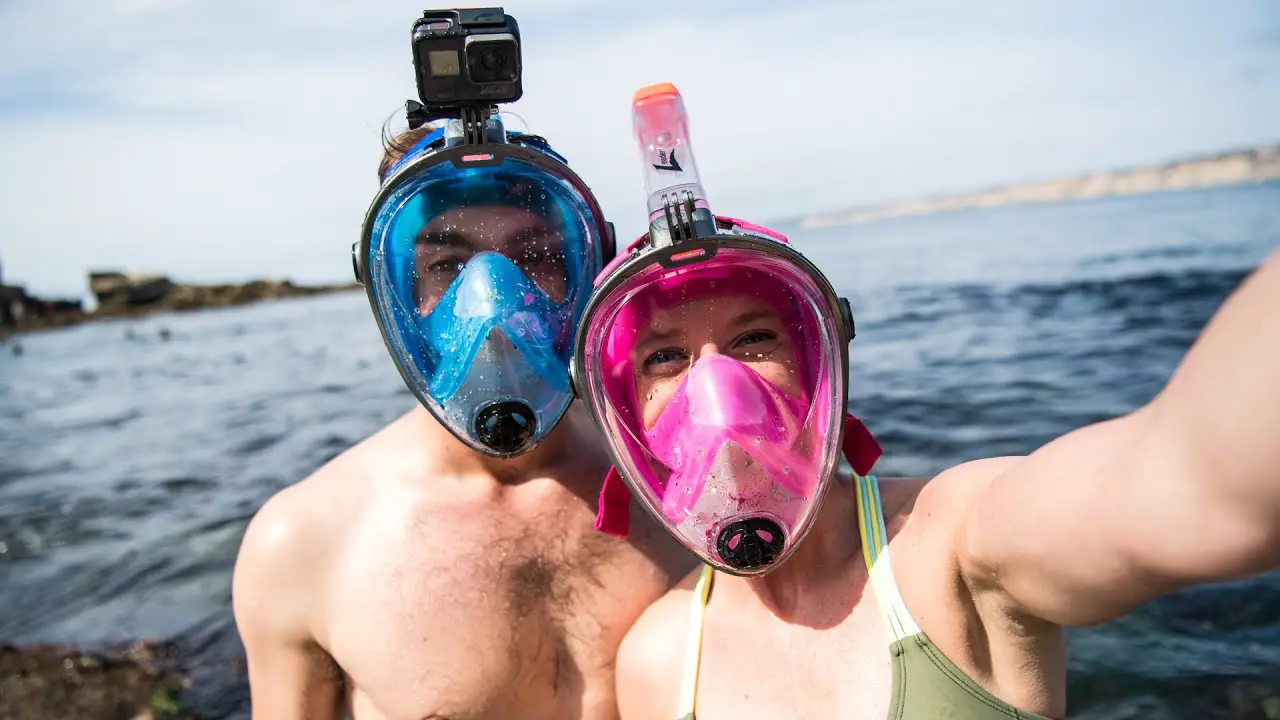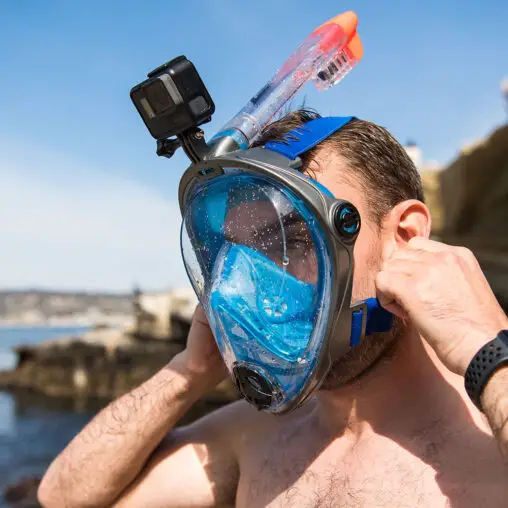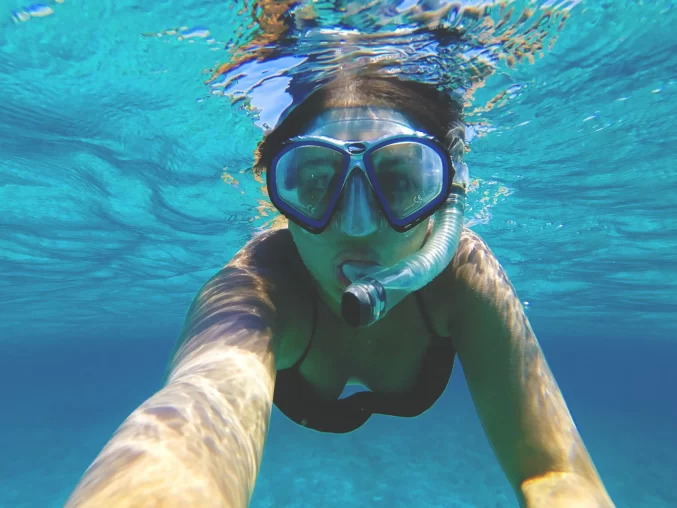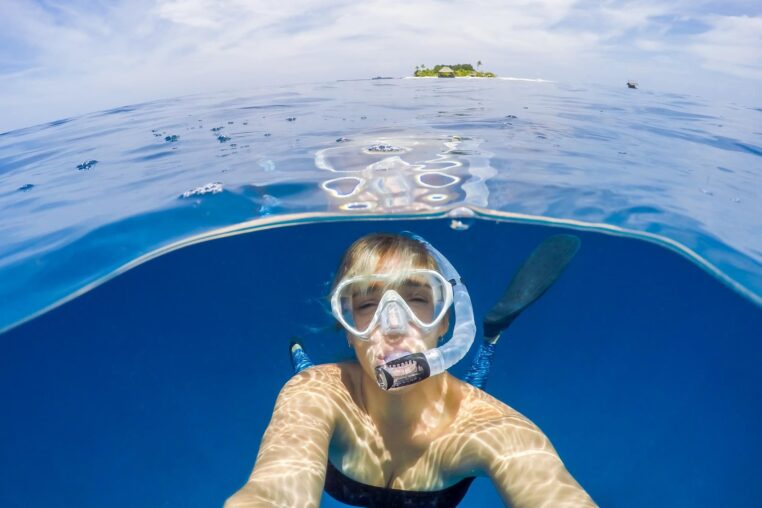
The underwater world has always held a magnetic allure for adventurers, calling them to uncover its hidden marvels. Full face snorkel masks, boasting innovative designs and the promise of enhanced comfort, have stirred the curiosity of many enthusiasts.
People often ponder whether these masks, equipped with their expansive air chambers, have the potential to grant them the ability to breathe underwater, ushering in a whole new realm of exploration possibilities.
So, can you breathe underwater with a full face mask? The answer is yes, but only at the water’s surface. Embrace the freedom of surface snorkeling, explore vibrant marine life, and breathe comfortably with your full face snorkel mask. Remember, adventure awaits just beneath the surface—enjoy it responsibly and safely!
In this comprehensive guide, we embark on a journey to uncover the true capabilities of full face snorkel masks.
We’ll explore how they differ from traditional snorkels and provide essential guidelines on what to do and what to avoid while using them. By the time you reach the end of this guide, you will possess a clear and informed understanding of what full face snorkel masks bring to the table and how to harness their advantages while ensuring your safety beneath the waves.
Understanding the Full Face Snorkel Mask

Full face snorkel masks have become increasingly popular in recent years, completely transforming the snorkeling experience. These masks stand out with their distinctive design, offering a comfortable alternative to traditional snorkels.
They allow users to breathe effortlessly through both their nose and mouth, sparing them the discomfort of dealing with a conventional mouthpiece. It’s easy to see why these masks have garnered so much attention and interest.
However, it’s important to clear up a common misunderstanding about full face snorkel masks. While they do provide a more comfortable and user-friendly snorkeling experience, they do not grant the ability to breathe underwater without any limitations.
In the underwater realm, safety remains a paramount concern, and it’s essential to understand the capabilities and limitations of these masks to ensure that you enjoy your snorkeling adventure while staying safe beneath the waves.
Surface Use with a Full Face Snorkel Mask
When used in the manner they were designed for, full face snorkel masks indeed extend the time you can comfortably spend underwater. With the snorkel tube kept above the water’s surface, users can enjoy approximately 15 minutes of uninterrupted underwater breathing before they may begin to encounter some difficulties due to the mask’s air chamber.
This feature makes these masks a great choice for surface snorkeling, a style of snorkeling where you can take in the beauty of the underwater world without the need to resurface frequently for a breath of fresh air.
The ability to stay submerged for a decent period offers snorkelers a chance to have more immersive encounters with marine life and explore the underwater environment with greater ease.
However, it’s essential to remember that the effectiveness of full face snorkel masks hinges on using them correctly and staying vigilant about your breathing and safety.
So, if you’re planning a surface snorkeling adventure, these masks can enhance your experience, but it’s wise to keep an eye on your underwater time to ensure a safe and enjoyable outing.
Full Submersion and Breathing Limitations
For those curious about the possibility of fully submerging with a full face snorkel mask and breathing underwater, the answer is less optimistic. While you might manage an extra breath or two, you’ll quickly run out of air.
In essence, a full face snorkel mask cannot provide continuous underwater breathing like scuba gear can. To achieve such an ability, an additional air supply source is necessary.
Differentiating Full Face Snorkel Masks from Traditional Snorkels

To appreciate the advantages and limitations of full face snorkel masks fully, it’s essential to understand the differences between them and traditional snorkeling equipment.
The Comfort Factor
Traditional snorkels require users to adapt to mouth-only breathing, which can be challenging for beginners accustomed to nasal breathing. Full face snorkel masks eliminate this hurdle, as they allow for both mouth and nose breathing. This adaptability makes them ideal for novices.
The Dry Snorkel Mechanism
Both full face snorkel masks and traditional snorkels can feature dry snorkel mechanisms. However, the term “dry” can be misleading. Dry snorkels are designed to prevent water from entering the snorkel tube, reducing the risk of choking or ingesting water. Nevertheless, dry snorkels are not designed to provide oxygen underwater; they merely facilitate surface breathing.
Depth Limitations
The length of the snorkel tube determines how deep you can venture underwater while maintaining access to fresh air. Since both full face snorkel masks and traditional snorkels rely on atmospheric air, they share the same depth restrictions—typically around 1-1.5 feet.
How Full Face Masks Benefit Beginners
Full face snorkel masks offer significant advantages, especially for those new to snorkeling:
- Ease of Breathing: Beginners often struggle with transitioning from nose breathing to mouth breathing. Full face masks, by allowing both forms of respiration, make the adjustment more seamless.
- Enhanced Comfort: Traditional snorkels with mouthpieces can lead to jaw fatigue and discomfort, discouraging newcomers. Full face masks eliminate this issue, making the experience much more enjoyable.
- Reduced Water Ingestion: Traditional snorkels, particularly non-dry snorkels, can allow water to enter, causing choking or swallowing. Full face masks equipped with dry snorkels minimize this risk.
Why Not to Dive with a Full Face Mask
While full face snorkel masks are excellent for surface snorkeling, attempting to dive with them can lead to numerous issues:
- Buoyancy Challenges: Full face masks trap air within their chamber, making them buoyant. This buoyancy can interfere with underwater diving, as the mask may pull you upward during descents.
- Ear Equalization Difficulties: Diving necessitates equalizing ear pressure, typically achieved by pinching the nose and exhaling—an action known as the Valsalva maneuver. Full face masks lack the ability to pinch the nose, making ear equalization challenging and painful, potentially leading to burst eardrums.
Conclusion
Full face snorkel masks are a game-changer for surface snorkeling, offering comfort and ease of breathing, making them particularly suitable for beginners. However, it’s crucial to remember that they do not enable continuous underwater breathing like scuba gear. When used as intended, these masks enhance the snorkeling experience by reducing common discomforts associated with traditional snorkels.
Attempting to dive with a full face mask is not advisable due to issues related to buoyancy and ear equalization. To ensure a safe and enjoyable snorkeling experience, it’s essential to understand the capabilities and limitations of your equipment and use it accordingly.









